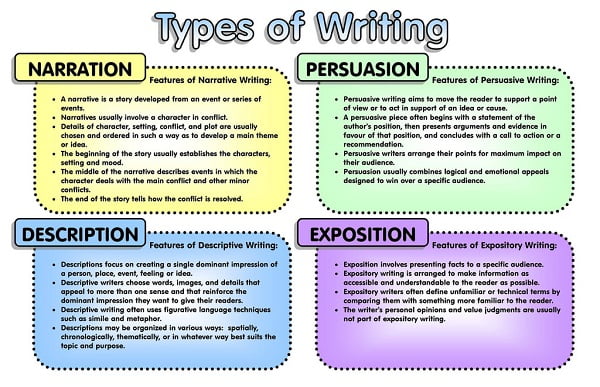What is a narrative essay? Simply put, writing narrative essays involve telling a story to exhibit a certain unique insight. Narrative writing enables writers to express themselves creatively and share their experiences with other people. A narrative story is just like a story told for a particular reason. The primary focus of each narrative essay is a plot that is created with the use of enough information to make a conclusion.
What is narrative writing? This type of writing consists of non-fiction works that follow a certain logical chronology. Most writers often utilize various anecdotes to relate their experiences and engross the reader. By doing this, you can give your narrative story a certain level of emotional appeal. This appeal can either be humorous or serious; however, it is important if you want your readers to connect with your story.
Page Contents
Traits of Successful Narrative Essays
- They make a central point.
- They comprise of specific details in favor of that central point.
- They are organized in time.

Tips on How to Write a Narrative Essay
- If you want to tell a story about your life experience, you need to narrate a story about an event or experience that means a lot to you. Doing this will make it easier for you to tell the story. Moreover, the narrative story will be outlined in an interesting manner.
- Steer clear of long introductions and get right to the action. You should also avoid lengthy descriptions, particularly at the beginning of the story.
- Make use of all your five sense in the description of the setting, characters, and plot. Mention what did you tasted, heard, saw, etc. Another important thing to do is tell your story in your own voice – don’t shy away! No one will pay much attention to a textbook story.
- Ensure that your narrative format has a point. Talk about what you’ve learned from this particular experience.
Key Elements of Good Narrative Essay Examples
- Narrative essays are written with vivid descriptions and sensory details to engage the readers.
- They normally have a purpose that is stated in the opening sentence.
- They may employ dialogue.
- Narrative essays examples are usually told chronologically.
How to Start a Narrative Essay: A Simple Guide
The Narrative Format for Essay Writing
The format of a narrative essay is almost similar to a general essay format:
- You begin from the introduction, which is supposed to be captivating to capture the reader’s attention.
- Next, you outline your plot in the body.
- Finally, you come up with a conclusion, explaining the lessons learned from that experience and how it can be useful to others.
One important thing to remember is that you should pay more attention to the plot; starting from the setting and characters, you need to describe a problem. After that, raise an action and go to the climax of the plot. Then, the stage of falling action follows that leads us to the conclusion of the story.
While writing your essay, you need to be driven by passion and utilize concrete details. Narrative writing offers students a great opportunity to score highly by telling a good story with passion, without having to concentrate on areas like persuasive writing and literary analysis.
Writing the Introduction
When it comes to the question of ‘‘how to start a narrative essay’’, the introduction starts with a hook (a leading statement about the story that grabs the attention of the reader). Then you continue with setting the scene: when did the event occur? Where? Under what circumstances? Having the ability to answer these questions will enable the reader to dig deep into the story and will be fascinated by it until the end. The introduction ends with a thesis statement that lets the reader know the truths or insightful experience stemming from your story.
Writing the Body
The main story develops in this section. It generally contains three paragraphs. The first one involves the engaging action (a catalyst of the event talked about in the reflective essay). Moreover, the second paragraph concentrates on the middle stage (the advancement of the story and hints to its significance). Finally, the third one describes the end action (what has been done to arrive at a resolution and the lessons learned from that experience).
During the process of narrative writing, it’s essential to list any sounds, feelings, tastes that the writer experienced in the story. The writer ought to draw the reader while refraining from making the narrative story sound like another summary. Make use of transitional words in order to make the flow and easy to perceive.
Writing the Conclusion
In this section, the writer presents his or her thoughts and analysis of the situation and also highlighting the reason why these experiences are important to the readers.
Seven Steps for Writing Successful Narrative Essay Examples
- Step 1 – Be ready to tell your story. Once you’ve selected a topic, start brainstorming your plotline.
- Step 2 – Have some kind of setting. Describe this setting. Utilize descriptive words and phrases or even metaphors and imageries.
- Step 3 – Create your reader’s idea of your characters. Do not involve too many characters, especially if it is a short story. Look for ways of naturally describing the features of your characters.
- Step 4 – Unfold the plot. Describe vividly all scenarios and actions of the characters such that a reader is able to visualize them.
- Step 5 – Plan the climax and twist in your narrative story. Remember not to introduce the culmination right from the start.
- Step 6 – Wind up your essay. Do not feel obliged to unfold each character’s storyline or talk about their future in detail.
- Step 7 – Revise your paper. Go through it and make any necessary changes. You can get a fresh pair of eyes to look at your work. Moreover, you can also read the essay out loud to some of your friends, relatives before handing it in.
Other Useful Details
- Narrative writing guidelines recommend beginning your narrative essay examples with an interesting quote, fact or even a question. Your readers will be intrigued and thus have the urge to read the rest of your story.
- Refrain from long-winded sentences in your introductory paragraph.
- With this kind of essay, you are supposed to write from your own viewpoint. Therefore, make use of suitable words that will express your mindset.
- Narrative essay examples are written in the first person narrative – follow this for your essay too.
Examples of Narrative Essay Topics
Selecting a topic may be the most challenging thing to do. Here are a few ideas to assist you to brainstorm topics:
- A Memorable Journey
- A Significant Misunderstanding
- An Embarrassing Event
- Your First Day At Work
- An Unexpected Encounter
- An Encounter With Someone You Were Afraid Of

Conclusion
There you have it. For those students bothered with questions such as “what is a narrative essay” or “what is narrative writing” the information provided above will assist you to know what a narrative essay, as well as descriptive essay, is and what is involved in writing it. You are supposed to narrate a story that has a specific point to be made. Your audience has to get a vivid idea or learn a lesson from your paper. Also, make use of emotional language.
Additionally, in case you’re swamped with a lot of assignments and don’t have time to write your narrative paper assignment, you can simply go online with your “how to write a narrative essay” question, and you’ll get assistance.
